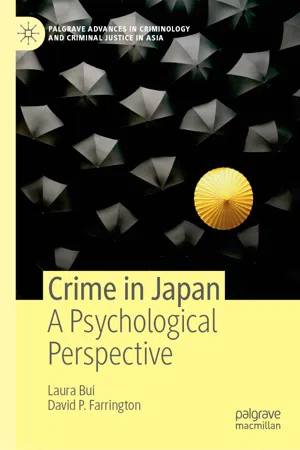In recent times, criminology in Asia has substantially grown, and it is a hybrid of Western1 influence and native interest from scholars and policy makers (Liu 2009). The post-war era witnessed Japan’s rise as an economic superpower followed by the four ‘Asian Tigers ’: Taiwan, Hong Kong, South Korea, and Singapore (Lee and Laider 2013; Liu 2009; Sheptycki 2008). These countries evidenced comparatively low crime rates , which supported the idea of ‘Asian exceptionalism ’. Despite differences between these countries, ‘Asian values ’ and ‘Confucian traditions’ were thought to contribute to low crime as well as to a different social order (Fukayama 1998; Karstedt 2001).
Criminologists from the Western World were particularly interested in Japan because of its low crime rate (Sheptycki 2008). It had been theorised that modernisation would increase crime, and this was confirmed by observations of increasing crime rates since the Second World War in every Western country that transformed from agricultural to industrial (Shahidullah 2014). Japan was the first non-Western country to modernise, but defied established knowledge by having comparatively low crime (Finch 2000; Westermann and Burfeind 1991), which has remained true even today. According to recent statistics released from the United Nations Office on Drugs and Crime (UNODC 2016), Japan had lower rates of major offences2 than the US , England and Wales, Germany , and France . Comparing low crime countries to high crime ones, Freda Adler (1983) attributed Japan’s low crime to synnomie , comprising norm conformity , cohesion, intact social controls, and norm integration. These traits did not seem to be prominent among countries with high crime.
Low Crime and Orientalism : A Brief History
Modernised and low crime Japan underscored a major issue in criminology: its ethnocentrism. Much knowledge about crime is derived from Western countries. Criminology, as a contemporary social science discipline, primarily developed in North America and Europe (Liu 2009). Many theoretical and methodological advances have been attributed to American criminologists, almost to the point that criminology is thought of as ‘American criminology ’, despite the fact that the discipline originated from Europe (Stamatel 2009; Marshall 2001). Consequently, there is an assumption that what applies in the American context is universally applicable (Liu 2007). The ‘Westernisation’ of knowledge is observed in cross-national studies of crime, whereby the underrepresentation of non-Western countries (Liu 2007) and the imposing of Western theories onto non-Western societies (Agozino 2004) are critical obstacles to creating a comprehensive and inclusive criminological knowledge base.
Japan, as an exception to modernisation theory , needed an explanation. Western scholars pointed to differences between countries as reasons for Japan’s low crime rate . They noted that Japanese culture prioritised the group and conformity , unlike Western cultures, such as the US , which prioritised the individual and autonomy (Miller and Kanazawa 2000). It was proposed that crime was low in Japan because committing crimes deviated from group norms and conventions, and therefore was widely disapproved.
Japanese values were also linked to overall ‘Asian values ’, in which Confucian beliefs, particularly ones promoting strong familial ties, were reasons for the country’s successes in not only boosting its economy, but also curbing crime (Karstedt 2001; Martinez 2007). Reference was, too, made to Japan’s homogeneous population, because it supported an integrated society, which prevented the breakdown of social norms, or anomie3 (Leonardsen 2002). Another popular explanation was the strong preservation of cultural traditions derived from Shinto, Buddhist , and Confucian beliefs (Smith and Sueda 2008). Japanese scholars, however, have attributed their recent weakening social ties and poor childhood socialisation to the deterioration of their cultural traditions, even arguing that Western Europe was better at preserving theirs (Smith and Sueda 2008).
There are several problems with these explanations from Western scholars. First, it was assumed that only one trajectory for modernisation existed; the implication was that modernisation, as observed in the West , was the universal model (Karstedt 2001). Second, explanations for Japan’s low crime were overly simplistic, because they did not elaborate the precise mechanisms that produced low crime (Komiya 1999). Third, cultural explanations were mere observations and had not been empirically validated, yet they were treated as facts (Takano and Osaka 1999). The homogeneity explanation was also based on mere widespread beliefs because, in actuality, Japan has several minority groups , such as the Ainu, resident Koreans, foreign workers, and Burakumin , that make up about 4% of the population (Sugimoto 2014). Although this is a small proportion compared to multi-ethnic societies such as the US and UK , Japan is not as homogeneous as it has been purported to be.
The danger with these types of explanations is that they encourage the
treatment of people and cultures judged to be different from the dominant group as ‘other’. Such perceptions, in turn, may lead to unfair discrimination and dehumanisation, which may directly and negatively affect life chances. Regrettably, these explanations are common in Western discourse on Japan. Take, for example, an excerpt from the beginning of the renowned anthropological study on Japan,
The Chrysanthemum and the Sword, by American
Ruth Benedict (
1946), who conducted this post-war research without ever learning Japanese or setting foot in Japan (Lie
2001):
The Japanese were the most alien enemy the United States had ever fought in an all-out struggle. No other war with a major foe had it been necessary to take into account such exceedingly different habits of acting and thinking. (Benedict 1946: 1)
Such descriptions emphasise differences. They promote dissimilarities, with the intention of reducing non-Western cultures and people to stereotypes and two-dimensional caricatures. In the case with Japan, Benjamin Goold (2004) referred to it as ‘idealising the other’. Goold argued that criminological texts on Japan, particularly David Bayley’s Forces of Order: Policing Modern Japan (1976) and John Braithwaite’s Crime, Shame, and Reintegration (1989), romanticised Japan and the Japanese, arguing that low crime was seen as the r...
